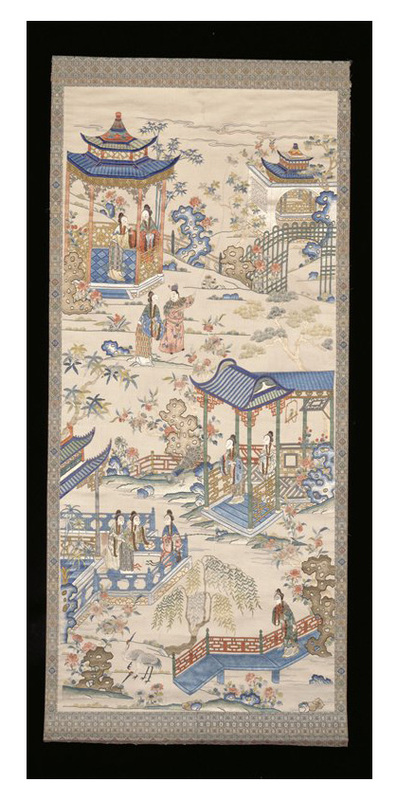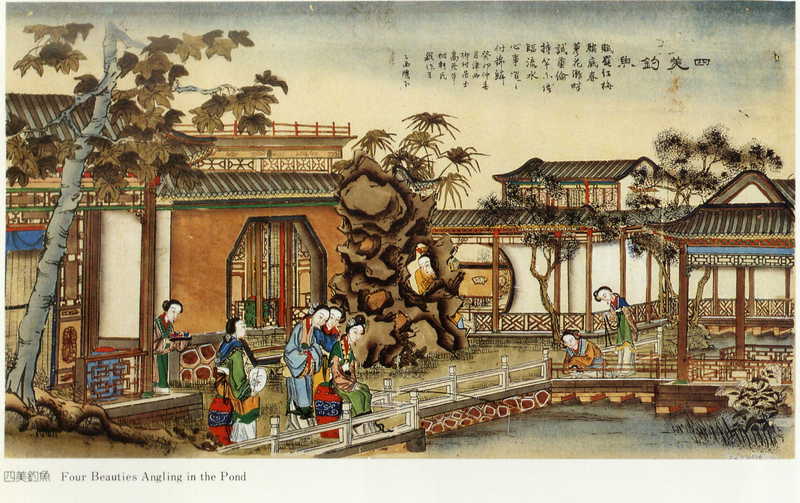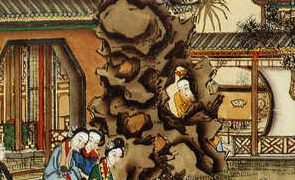Embroidery of Scenes from Dream of the Red Chamber

Waltner, Ryor, and Kucera Discuss a Narrative Embroidery of Dream of the Red Chamber at the Minneapolis Institute of Art
Ann Waltner, Kathleen Ryor and Karil Kucera discuss a narrative embroidery of scenes from the Dream of the Red Chamber held at the Minneapolis Institute of Art. They stress the quality of the embroidery and the fact that it was almost certainly made in a professional workshop rather than in a domestic setting.. They are also interested in the fact that the embroidery portrays a world of women in the garden. Baoyu is the only male figure in the embroidered garden, and he appears only once. (Other characters appear more than once–the embroidery is structured as a continuous narrative with more than one scene.) The garden is a liminal space, where men and women might mingle. Gardens in Chinese fiction and drama are often seen as potentially dangerous spaces.
Specific notes on the conversation
Waltner mentions Yangliuqing New Year’s Prints. New Year’s Prints are so-called because they were purchased and pasted on walls every New Year. Yangliuqing is a famous printing house near Tianjin. The print Waltner refers to in the video is reproduced at the bottom of this page.
They discuss Baoyu’s 寶玉 wish that he be reborn a woman. Tealeaf (Mingyan茗煙), Baoyu’s trusted servant, articulates the wish that Baoyu 寶玉 be reborn in the next life as a woman. In chapter 78, Grandmother Jia speculates that perhaps Baoyu had been a “maid” in a former life, and suggests that it might have been better had he been born a girl.
Waltner also mentions that the scholar Ellen Widmer has argued that the novel represented a change in the way women read fiction. That argument is made in her book The Beauty and the Book.
Waltner suggested that there were visual resonances between the embroidery and the Yangliuqing New Year’s prints. She in particular mentioned resonances between the fishing scene at the bottom of the embroidery and the woodblock print of “Four Beauties Angling,” reproduced here for you to examine.
Note that in the woodblock print, Baoyu is very nearly concealed behind a rock–he is, as always, visible by the red on his headdress. And it is perhaps worthy of note that even though he is nearly concealed, he is at the center of the image.


Translation of Poem on Woodblock Print of Four Beauties Angling
四美釣魚
賦罷紅梅腕底春
蓼花灘畔試垂綸
持竿小語臨流水
心事迢迢付錦鱗
癸卯仲春月津西柳村居士高荫章桐轩氏戏作Four Beauties Angling
They wrote poems on red flowers, spring emerged from their fingers.
Among the lianhua flowers along the shore, they dangle their fishing lines.
They chat while holding their poles, facing the flowing water.
Their hopes and dreams are attached to those glimmering fins.
Translated by Ann Waltner’s reading group: Zhu Tianxiao, Eric Becklin, Lars Christensen, Jiang Yuanxin.
Notes on poem
The episode described in this poem is in chapter 81. 腕底春 can refer to paintings of spring which are created “under the wrist.” The fishing that the four beauties are engaged in is to see who has good fortune, thus the last line. The line we have translated “glimmering fins” (錦鱗) would literally be translated as “brocade scales.”

